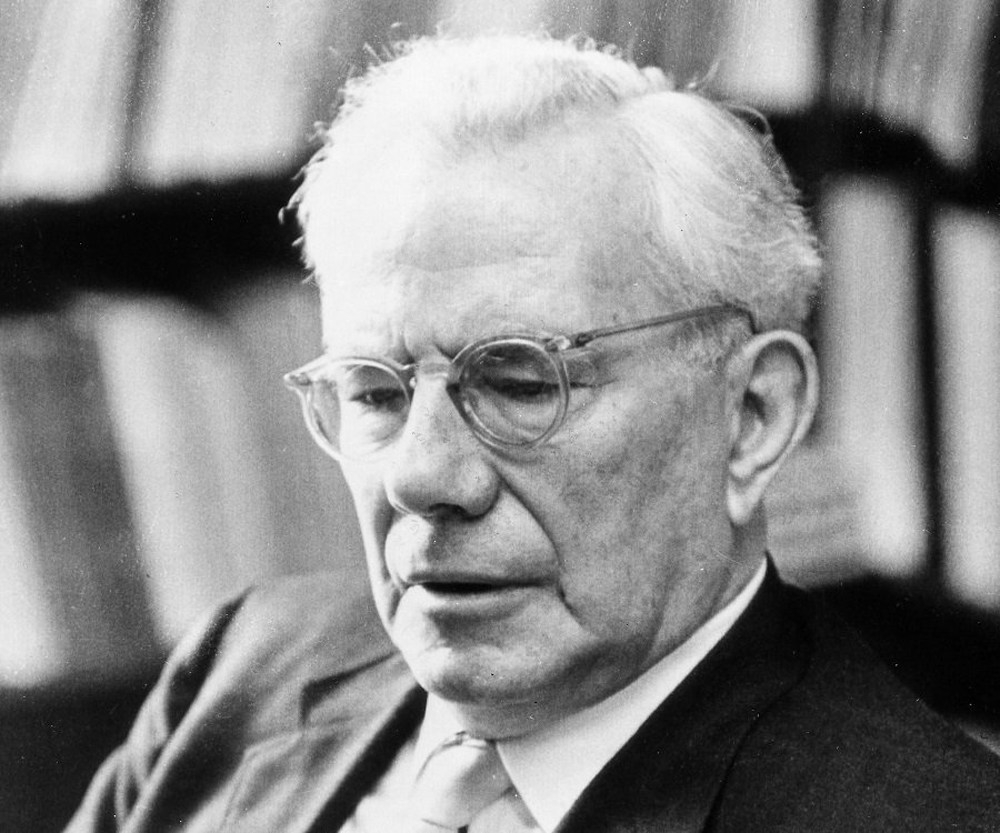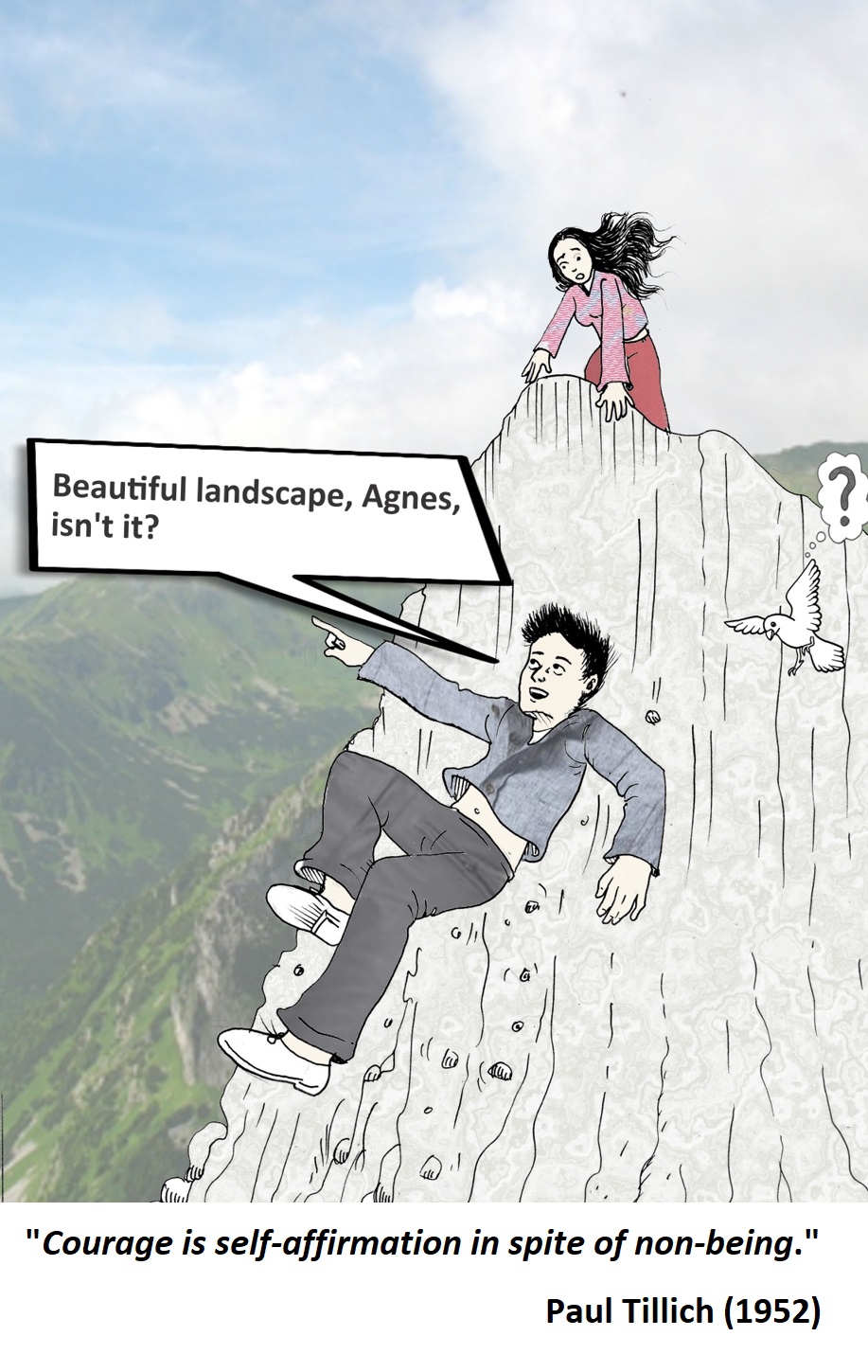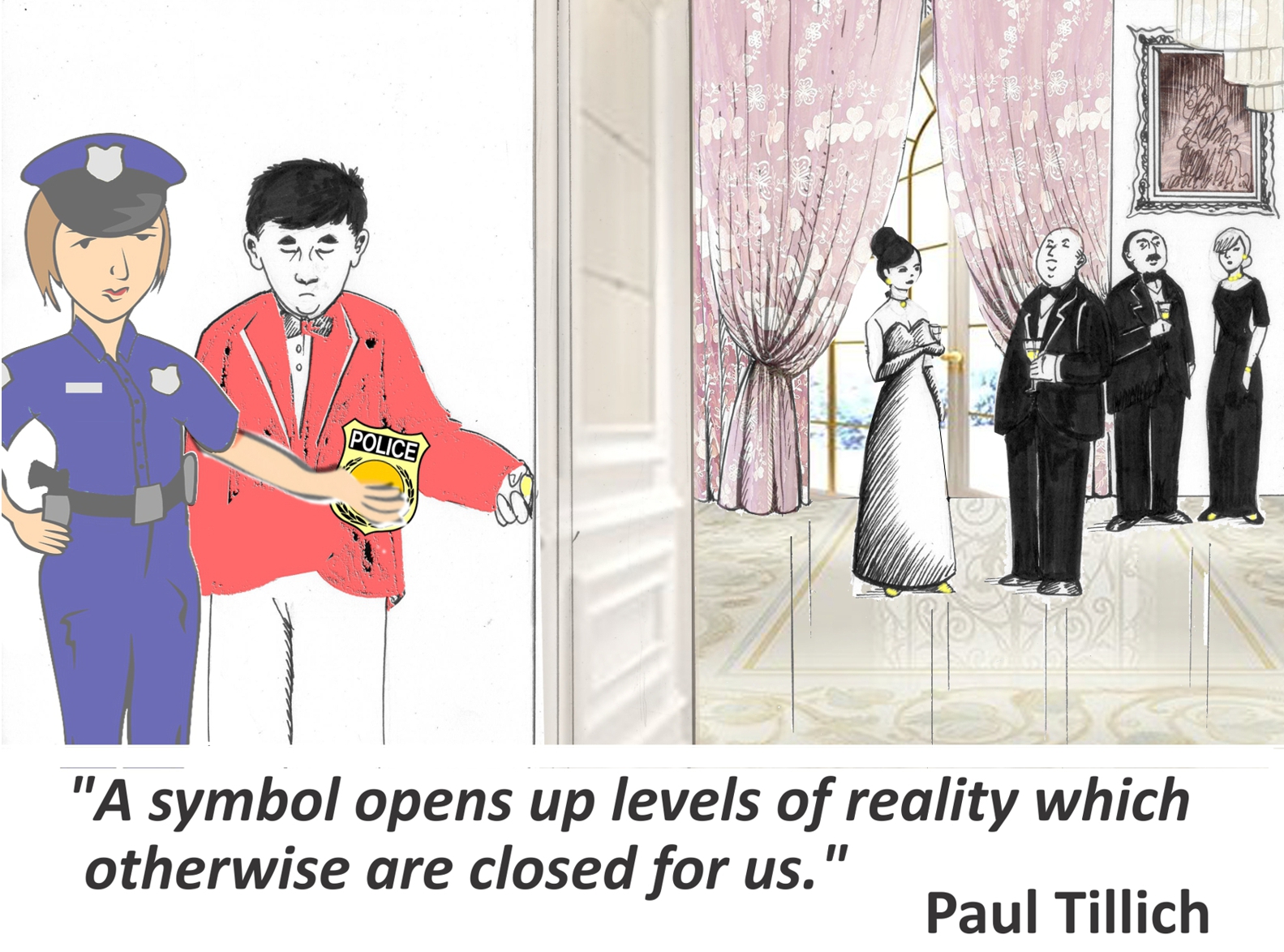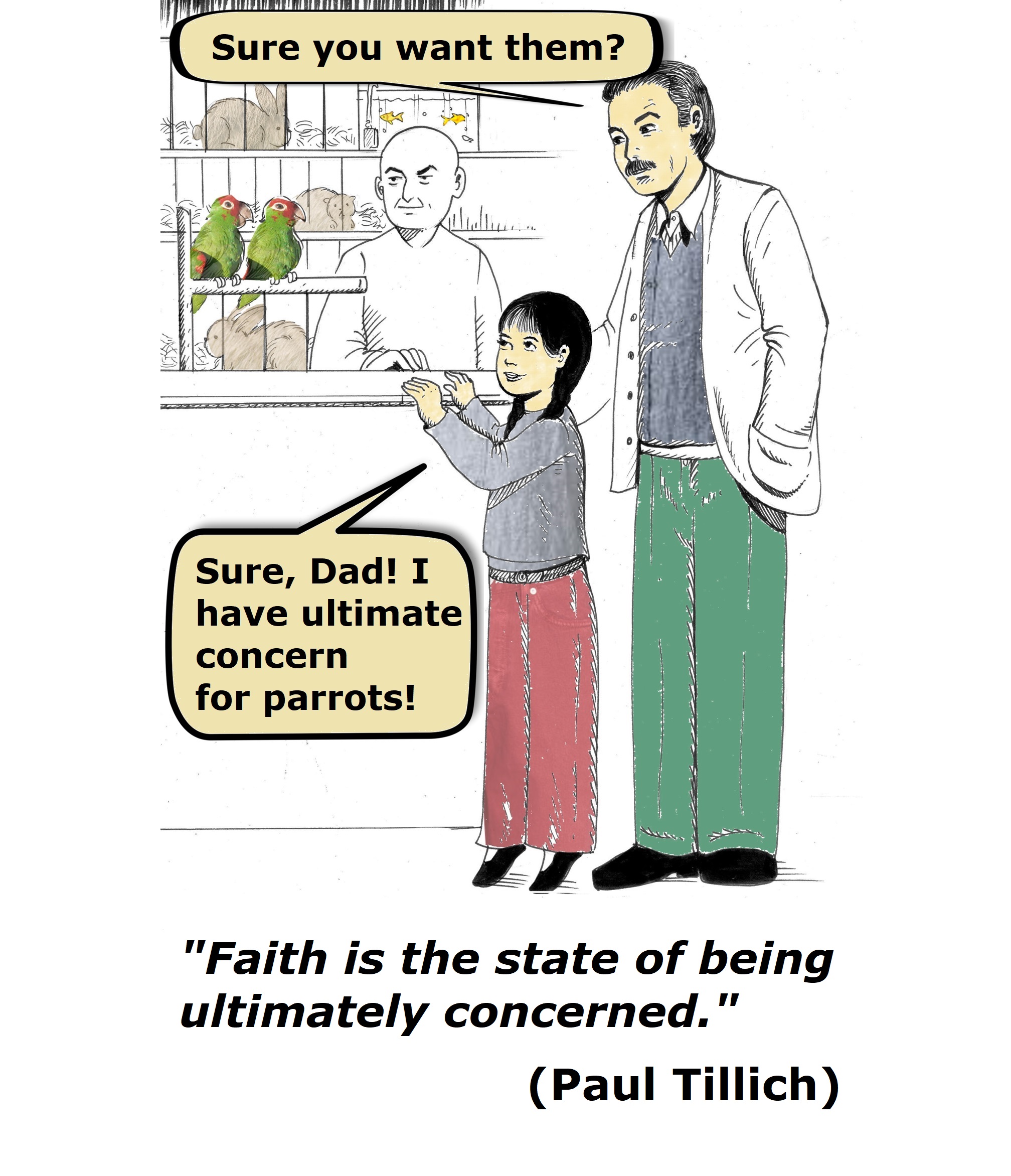LIST OF PHILOSOPHERS
THEMES ON THIS PAGE:
| 1. THE COURAGE TO BE | 2. SYMBOLS AND THE BEYOND | 3. FAITH |

Paul Tillich (1886-1965) was an important German-American philosopher, Christian existentialist, and Lutheran theologian. He grew up in Germany, became a Lutheran minister, and taught theology at the Universities of Berlin, Marburg, Leipzig and Frankfurt. In 1933 he was dismissed from university by the Nazi party, and he moved to New York at the age of 47. He taught at several academic universities, among them Harvard and the University of Chicago, and published several influential books. He died at the age of 79 from a heart attack.
| TOPIC 1. THE COURAGE TO BE |
 For Tillich, basic life-issues, or existential issues, take us to the question what it means to exist as a finite human being. This question is at the center of his book The Courage to Be (1952), his most popular book. To understand the text below, it is important to keep in mind three concepts: anxiety, courage, and vitality.
For Tillich, basic life-issues, or existential issues, take us to the question what it means to exist as a finite human being. This question is at the center of his book The Courage to Be (1952), his most popular book. To understand the text below, it is important to keep in mind three concepts: anxiety, courage, and vitality.
Tillich explains that as finite creatures, we encounter three basic threats to our being: our death, our guilt, and meaninglessness. Thus, our encounter with the possibility of our non-being raises in us three types of anxiety: anxiety of death, anxiety of our guilt and sin, and anxiety of lack of meaning. These three anxieties appear in different degrees at different historical periods and in different individuals. For example, in today’s world the anxiety of meaninglessness is the most dominant, although, of course, the other two exist too.
Courage, for Tillich, is our way of struggling with these anxieties. We cannot eliminate them – they are part of what it means to be a finite human being. But in courage we accept the threat of non-being, we take it into us as part of who we are, and by doing so, we avoid despair and we live more fully. As Tillich puts it, in courage I affirm my being despite the threat of non-being. The power to do so is what Tillich calls vitality, or life power.
The following passages are taken from his The Courage to Be, with minor linguistic simplifications.
From CHAPTER 2
Anxiety is the state in which a [human] being is aware of its possible non-being. The same statement, in a shorter form, would read: Anxiety is the existential awareness of non-being. “Existential” in this sentence means that it is not the abstract knowledge of non-being which produces anxiety, but the awareness that non-being is a part of one’s own being. What produces anxiety is not a realization of universal temporary, not even the experience of the death of others, but the always-latent awareness of our own having to die. Anxiety is finitude, experienced as one’s own finitude. This is the natural anxiety of a human as human, and in some way of all living beings. It is the anxiety of non-being, the awareness of one’s finitude as finitude.
[…] I suggest that we distinguish three types of anxiety according to the three directions in which non-being threatens being. Non-being threatens man’s ontic self-affirmation, relatively in terms of fate [=specific things happen by chance], absolutely [=the horizon of all possibilities] in terms of death. It threatens man’s spiritual self-affirmation, relatively in terms of emptiness [=specific things lose their meaning], absolutely in terms of meaninglessness [=of life in general]. It threatens man’s moral self-affirmation, relatively in terms of guilt [=about specific actions], absolutely in terms of condemnation. The awareness of this three-fold threat is anxiety which appears in three forms, that of fate and death (briefly, the anxiety of death), that of emptiness and loss of meaning (briefly, the anxiety of meaninglessness), and that of guilt and condemnation (briefly, the anxiety of condemnation). In all three forms, anxiety is existential in the sense that it belongs to existence as such, and not to an abnormal state of mind as in neurotic (and psychotic) anxiety.
From CHAPTER 3
We have seen that anxiety tends to become fear [fear, unlike anxiety, is about a specific object] in order to have an object which courage can deal with. Courage does not remove anxiety. Since anxiety is existential, it cannot be removed. But courage takes the anxiety of non-being into itself. Courage is self-affirmation “in spite of,” namely in spite of non-being. A person who acts courageously takes, through his self-affirmation, the anxiety of non-being upon himself. Both prepositions – “into” and “upon” – are metaphoric, and they point to anxiety as an element within the total structure of self-affirmation, the element which gives self-affirmation the quality of “in spite of” and transforms it into courage. Anxiety turns into courage, because the other alternative is despair. Courage resists despair by taking anxiety into itself.
[…] Courage, in this view, is the readiness to take upon oneself a negative that is anticipated by fear, for the sake of a fuller positivity. Biological self-affirmation implies the acceptance of lack, work, insecurity, pain, possible destruction. Without this self-affirmation, life could not be preserved or increased. The more vital strength a being has, the more he is able to affirm himself in spite of the dangers that are announced by fear and anxiety.
[…] Life, in consequence, includes both fear and courage, as elements of a life-process in a changing but essentially established balance. As long as life has such a balance, it is able to resist non-being. Unbalanced fear and unbalanced courage destroy the life whose preservation and increase are the function of the balance of fear and courage.
A life-process which shows this balance, and with it the power of being, has, in biological terms, vitality, in other words, life power. The right courage, therefore, like the right fear, must be understood as the expression of perfect vitality. The courage to be is a function of vitality. Diminishing vitality consequently entails diminishing courage. To strengthen vitality means to strengthen the courage to be.
| TOPIC 2. SYMBOLS AND THE BEYOND |
 For Tillich, we are able to go beyond our normal boundaries, thanks to symbols. SYMBOLS, as Tillich defines them, are different from conventional signs. Among other things, they open for us a reality which we cannot access in other ways. For example, a poem can open for us an aesthetic dimension which we cannot access otherwise; a ceremony can open for us social meanings which we cannot appreciate in other ways; and a religious ritual can open us to a spiritual dimension. These are therefore examples of symbols.
For Tillich, we are able to go beyond our normal boundaries, thanks to symbols. SYMBOLS, as Tillich defines them, are different from conventional signs. Among other things, they open for us a reality which we cannot access in other ways. For example, a poem can open for us an aesthetic dimension which we cannot access otherwise; a ceremony can open for us social meanings which we cannot appreciate in other ways; and a religious ritual can open us to a spiritual dimension. These are therefore examples of symbols.
Tillich’s conception of symbols is discussed in his short but influential book Dynamics of Faith (1957), which deals with philosophy of religion. (Notice that philosophy of religion is not the same as theology, since it is not committed to any specific religion.) Although the book’s purpose is to explore the nature of faith, in Chapter 3 it discusses symbols in general, in order to prepare the ground for explaining how religious symbols open us to divine reality. Here it lists six characteristics of symbols.
From CHAPTER 3
Symbols have one characteristic in common with signs: They point beyond themselves to something else. The red sign at the street corner points to the instruction to stop the movements of cars at certain intervals. A red light and the stopping of cars have essentially no relation to each other, but conventionally they are united as long as the convention lasts. The same is true of letters and numbers, and partly even words. They point beyond themselves to sounds and meanings. They are given this special function by convention within a nation, or by international conventions as the mathematical signs. Sometimes such signs are called symbols, but this is unfortunate because it makes the distinction between signs and symbols more difficult.
Decisive is the fact that signs do not participate in the reality of that to which they point, while symbols do. Therefore, signs can be replaced for reasons of convenience or convention, while symbols cannot.
This leads to the second characteristic of the symbol: It participates in that to which it points: the flag participates in the power and dignity of the nation for which it stands. Therefore, it cannot be replaced except after a historic catastrophe that changes the reality of the nation which it symbolizes. An attack on the flag is felt as an attack on the majesty of the group in which it is acknowledged. Such an attack is considered blasphemy.
The third characteristic of a symbol is that it opens up levels of reality which otherwise are closed for us. All arts create symbols for a level of reality which cannot be reached in any other way. A picture and a poem reveal elements of reality which cannot be approached scientifically. In the creative work of art, we encounter reality in a dimension which is closed for us without such works.
The symbol’s fourth characteristic not only opens up dimensions and elements of reality which otherwise would remain unapproachable, but also unlocks dimensions and elements of our soul which correspond to the dimensions and elements of reality. A great play gives not only a new vision of the human scene, but it opens up hidden depths of our own being. Thus we are able to receive what the play reveals to us in reality. There are within us dimensions of which we cannot become aware except through symbols, as melodies and rhythms in music.
Symbols cannot be produced intentionally – this is the fifth characteristic. They grow out of the individual or collective unconscious and cannot function without being accepted by the unconscious dimension of our being. Symbols which have an especially social function, as political and religious symbols, are created or at least accepted by the collective unconscious of the group in which they appear.
The sixth and last characteristic of the symbol is a consequence of the fact that symbols cannot be invented. Like living beings, they grow and they die. They grow when the situation is ripe for them, and they die when the situation changes. The symbol of the “king“ grew in a special period of history, and it died in most parts of the world in our period. Symbols do not grow because people are longing for them, and they do not die because of scientific or practical criticism. They die because they can no longer produce a response in the group where they originally found expression.
| TOPIC 3. FAITH |
 What does it mean to have faith – faith in pacifism or in socialism or in White supremacy, faith in one’s nation or in one’s leader, faith in Christianity or Hinduism or in scientific atheism?
What does it mean to have faith – faith in pacifism or in socialism or in White supremacy, faith in one’s nation or in one’s leader, faith in Christianity or Hinduism or in scientific atheism?
This is a central issue which Paul Tillich addresses in his influential book Dynamics of Faith (1957). In the introduction to the book he says that “There is hardly a word in religious language, both theological and popular, which is subject to more misunderstandings, distortions and questionable definitions than the word ‘faith’. It confuses, misleads, creates alternately skepticism and fanaticism…”
Tillich’s goal is to “heal” this word. The definition which he offers is provocative and controversial. For him, faith is not an intellectual belief in some principles or ideas, nor is it an emotional attraction. Faith is not just intellectual and not just emotional, but an act of the entire personality. As he explains in Chapter 1, faith is an act that involves the entire person and orients his entire personality towards something he regards as ultimate, as infinitely important. Faith is “ultimate concern” – this is the heart of Tillich’s definition.
Of course, not every faith is equally valid. Faith in money, for example, or in a racist ideology, is not a true faith, because it is about something that is not really ultimate, and also because it is not a centered act that unifies the person with the object. But the issue of the truth of faith, like other issues, is discussed later in the book. The passages below, taken from the beginning of the book (with slight editing), sketch the meaning of faith in general.
From CHAPTER 1: WHAT FAITH IS, Section 1. Faith as ultimate concern
Faith is the state of being ultimately concerned: the dynamics of faith are the dynamics of man’s ultimate concern. Man, like every living being, is concerned about many things, above all about those things which condition his very existence, such as food and shelter. But man, in contrast to other living beings, has spiritual concerns – cognitive, aesthetic, social, political. Some of them are urgent, often extremely urgent, and each of them, as well as the vital concerns, can claim ultimacy for a human life or the life of a social group. If it claims ultimacy, it demands the total surrender of the person who accepts this claim, and it promises total fulfillment even if all other claims have to be subjected to it or rejected in its name. If a national group makes the life and growth of the nation its ultimate concern, it demands that all other concerns, economic well-being, health and life, family, aesthetic and cognitive truth, justice and humanity – be sacrificed. The extreme nationalisms of our century are laboratories for the study of what ultimate concern means in all aspects of human existence, including the smallest concern of one’s daily life. Everything is centered in the only god, the nation – a god who certainly proves to be a demon, but who shows clearly the unconditional character of an ultimate concern.
But what is accepted in the act of faith is not only the unconditional demand made by what is one’s ultimate concern, it is also the promise of ultimate fulfillment. The content of this promise is not necessarily defined. It can be expressed in indefinite symbols or in concrete symbols which cannot be taken literally, like the “greatness” of one’s nation in which one participates even if one has died for it, or the conquest of mankind by the “saving race,” etc. In each of these cases an “ultimate fulfillment” is promised, and one is threatened to be excluded from such fulfillment if the unconditional demand is not obeyed.
[…]
Another example – almost a counter-example, yet nevertheless equally revealing – is the ultimate concern with “success” and with social status and economic power. It is the god of many people in the highly competitive Western culture, and it does what every ultimate concern must do: It demands unconditional surrender to its laws, even if the price is the sacrifice of true human relations, personal convictions, and creative Eros. Its threat is social and economic defeat, and its promise – indefinite like all such promises – is the fulfillment of one’s being. […] When fulfilled, the promise of this faith proves to be empty.
Section 2. Faith as a centered act
Faith as ultimate concern is an act of the total personality. It happens in the center of the personal life and includes all its elements. Faith is the most centered act of the human mind. It is not a movement of a special section or a special function of man’s total being. They are all united in the act of faith. But faith is not the sum total of their impacts. It transcends every special impact, as well as the totality of them, and it has itself a decisive impact on each of them.
[...] Faith as an act of the total personality is not imaginable without the participation of the unconscious elements in the personality structure. These elements are always present and decide largely about the content of the faith. But on the other hand, faith is a conscious act, and the unconscious elements participate in the creation of faith only if they are taken into the personal which transcends each of them. If this does not happen, if unconscious forces determine the mental status without a centered act, faith does not occur, and compulsions take its place. […] Man is able to decide for or against reason, he is able to create beyond reason or to destroy below reason. This power is the power of his self, the center of his self-relatedness in which all elements of his being are united. Faith is not an act of his rational functions, as it is not an act of the unconscious, but it is an act in which both the rational and the nonrational elements of his being are transcended.
Faith as the embracing and centered act of the personality is “ecstatic.” It transcends both the drives of the nonrational unconscious and the structures of the rational conscious. It transcends them, but it does not destroy them. […] “Ecstasy” means “standing outside of oneself” – without stopping to be oneself – with all the elements which are united in the personal center.
Section 3. The source of faith
We have described the act of faith and its relation to the dynamics of the personality. Faith is a total and centered act of the personal self, the act of unconditional, infinite and ultimate concern. The question now arises: What is the source of this all-embracing and all-transcending concern?
[…]
The unconditional concern which is faith is the concern about the unconditional. This infinite passion as faith has been described, is the passion for the infinite. Or, to use our first term, the ultimate concern is concern about what is experienced as ultimate. In this way we have turned from the subjective meaning of faith as a centered act of the personality to its objective meaning, to the thing that is meant in the act of faith.
When you subscribe to the blog, we will send you an e-mail when there are new updates on the site so you wouldn't miss them.
